
First Shokai : Roots of the Sukajan in Dobuita Street, Yokosuka
It seems that Sukajan was born on Dobuita Street. Please research the history of the birth of Sukajan and whether there are still people wearing it on Dobuita Street.
Sukajan, which was born on Dobuita Street as a souvenir from the occupation forces, is synonymous with Yokosuka and is deeply popular among Japanese people. At a time when the cultural heritage that tells the story of postwar history is faced with the issue of a shortage of craftsmen, new prospects are opening up.
Speaking of "Sukajan'', people tend to associate it with delinquent images such as flashy embroidery on the back, delinquent, tight-fitting clothes, and Regent clothes, but if you unravel the history of its birth and development, its postwar history will be revealed. It is also a valuable cultural heritage.

This is a monophonic sukajan! Special items lined up inside the long-established “First Shokai” store
What is the origin of Sukajan?
The "ska" in Sukajan is, of course, the Yokosuka ska (though, strictly speaking, there are various theories). In the first place, after World War II, American soldiers stationed in Yokosuka brought fabric as souvenirs to their home country to a tailor who had a shop on Dobuita Street near the base, and asked them to make jumpers. It all started when I received oriental embroidery such as an eagle. It is said that the first cloth brought by American soldiers was parachute fabric (silk).
By the way, why was Dobuita Street called ``Dobuita''? That's because the Dobu River used to flow there. Because the river was an obstruction to traffic, the Imperial Japanese Navy Arsenal provided iron plates and covered the drains, hence the name ``Dobita Street.'' It is said that
Before the war, it flourished as a gate town for the Imperial Navy Yokosuka Naval Base, and after the war it became a souvenir shop, bar, and restaurant for the Occupation Forces, and later for American soldiers stationed at the U.S. Army Yokosuka Base. It flourished as a shopping street lined with stores and tailor shops.
For this reason, the Skajan jacket was initially called the ``souvenir jacket'' by American soldiers. It changed its name to the original jumper "Sukajan" from Yokosuka due to its links with new Japanese youth culture such as the rockabilly and rock 'n' roll boom of the 1960s and the Yankee boom of the 1970s, as well as the influence of American soldiers. This is because the customer base has shifted to Japanese.
What is the current situation in the local area of Sukajan, which has a history of post-war Showa era? In order to respond to Tako-san's request, I visited Dobuita Street in mid-May, just after the Reiwa era.
We ask the chairman of the Shopping District Promotion Association what he is up to now, more than a year after the "Declaration of the Birthplace of Sukajan"
The road to Dobuita-
dori Dobuita-dori is a 3-minute walk from Shiori Station. It is a shopping street with a total length of about 300 meters that stretches from east to west.
In fact, on February 12, 2018 (Heisei 30) last year, an event called ``Declaration of the Birthplace of Sukajan'' was held at Dobuita Dori Shopping Street. Yokosuka Mayor Katsuaki Kamiji and House of Representatives member Shinjiro Koizumi also wore Skajan jackets and gave speeches on stage, making it a huge success.
The commemorative plate made at that time is now embedded in the ground on Dobuita Street.

“Declaration of the Birthplace of Sukajan” commemorative plate embedded in the street
More than a year has passed since that event, and I visited the shop of Masamitsu Koshikawa, the chairman of the Dobuita Dori Shopping Street Promotion Association, to find out about the current state of Skajan jackets.
Chairman Koshikawa runs Futaba Costume Rental Store, located near the entrance to Dobuita Street. The store is a long-established store that has been in business for over 70 years.
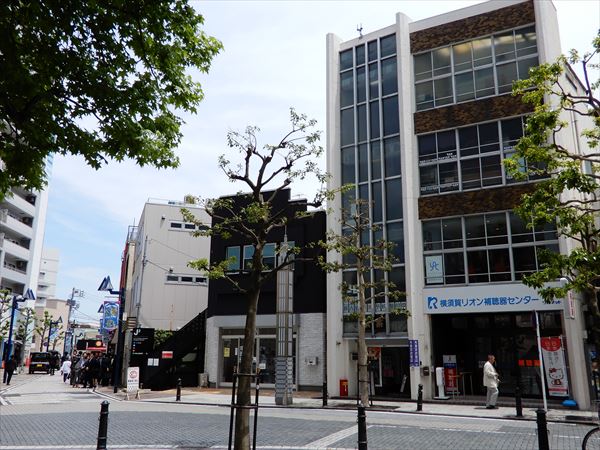
Futaba Costume Shop is on the 3rd floor of the building on the right where the hearing aid store is located. What you can see on your left is “Dobuita Street”
According to Chairman Koshikawa, since the declaration, the number of customers coming from outside the city and prefecture to buy sukajans has increased, and neighboring stores off Dobuita Street have started purchasing skajans. The advertising effect seems to have been great.
The union is taking advantage of this opportunity to take even more proactive measures. For example, the sukajan jacket with the Olympic emblem embroidered on it is currently being produced for next year's Tokyo Olympics. This is said to be a joint project with the government.
They also made original T-shirts with a Sukajan pattern on them, which are currently on sale at Dobuita Station, an information center and antenna shop on Dobuita Street (2,700 yen including tax).

Chairman Koshikawa unfolds his “Sukajan T-shirt” to show us
We also spoke about the future of Skajan.
``Nowadays, even when it comes to sukajan, there are a wide variety of jackets. Cheap ones can be found for less than 10,000 yen, and high-quality ones can cost around 50,000 yen. As a union, we would like to differentiate ourselves.We would like to support the ``one-of-a-kind hand-sewn sukajan'' that customers who are looking for the real thing are looking for.''However, there are still products that require advanced sewing techniques
. The number of craftsmen who do this is said to be decreasing. That seems to be one of the big issues. After leaving Futaba Rental Costume Shop and visiting the
Sukajan specialty shops along Dobuita Street , I immediately set foot on Dobuita Street.

Dobuita Street has a quiet atmosphere in the afternoon on weekdays after the long holidays.
First, let's take a look at Dobuita Station, which sells Sukajan T-shirts.

“Dobuita Station” storefront
At the entrance, the ``Sukajan T-shirt'' I saw earlier was hung, along with tourist information guidebooks and maps. Inside the store, souvenirs such as various types of original T-shirts, navy curry, famous Yokosuka sweets, and miscellaneous goods are sold.
What particularly caught my eye was a photo frame on the wall to the left as I entered, proclaiming ``Yokosuka Stories of the Past and Present.''

There are many past and present photos of various parts of Yokosuka City.
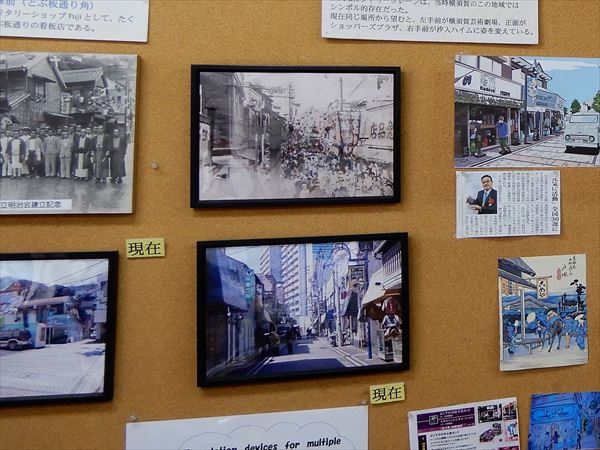
Of course, there was also a photo of Dobuita Street.
To the left of Dobuita Station, there was a woody shop with Skajan jackets displayed in its window.

Sukajan in the shop window

Store adjacent to Dobuita Station
This store was ``MIKASA vol.2,'' one of the Sukajan specialty stores that handles authentic original products that Chairman Koshikawa said he would like to support. The company was founded in 1952 (Showa 27), when the San Francisco Peace Treaty went into effect and Japan regained its sovereignty. It is a long-established store.
I immediately entered the store and listened to the store manager, Kazuyoshi Hitomoto.
According to Director Koshikawa, Mr. Ippon is one of the key players in revitalizing Sukajan, including the ``Birthplace Declaration.''

The inside of the store. Ippon-san is in the back
According to Mr. Ippon, sales have indeed been steady since the ``Birthplace Declaration'', but even before that, Gucci and Louis Vuitton had used Sukajan at the 2016 Paris Fashion Week, drawing attention both domestically and internationally. It is said to be large. Since then, they have been featured more frequently in fashion magazines and on TV, and says, ``Normally fashion trends change every one to two years, but the demand for skajans has been stable, and it feels like their popularity has completely taken root.'' .
I asked Mr. Ippon which products are particularly popular in his store. The product he told me about is the one pictured below. It is said to be the most popular original design sukajan.

The most popular Sukajan. The price is 18,000 yen (excluding tax)
They also showed us some of their special items.

The one and only full order. This is 50,000 yen (excluding tax)
By the way, some Sukajan jackets have "Yokosuka" written on them, some have "Japan" written on them, and some have both written on them. As a souvenir for American soldiers, it was difficult to tell where the product was located using the word "Yokosuka," so they began to use the word "Japan," but Mr. Ippon is particular about using the name "Yokosuka."
Afterwards, I was able to talk to her mother, Reiko Hitomoto, the store's president, about the changes in her customer base.
When asked whether American soldiers still come to buy Skajan jackets as souvenirs, she answered, ``When a warship comes to port, there are people who come to buy them, but usually most of them are Japanese.'' thing. On the other hand, the number of foreign tourists has been increasing recently. Apparently some foreigners come to us saying that the restaurant was introduced in the guidebook on the plane.
She wanted to interview a different type of store besides the long-established ones, so she went further down Dobuita Street and found a kitschy store on her left.

A child's mannequin wearing a Skajan jacket is so cute!
When I entered the store, I found a cheerful black man there. This is Emmanuel, the owner of the HIPHOP casual shop ``ACTIVE SOUL.''
Mr. Emmanuel came to Japan from Nigeria 17 years ago and immediately started his current shop here on Dobuita Street.
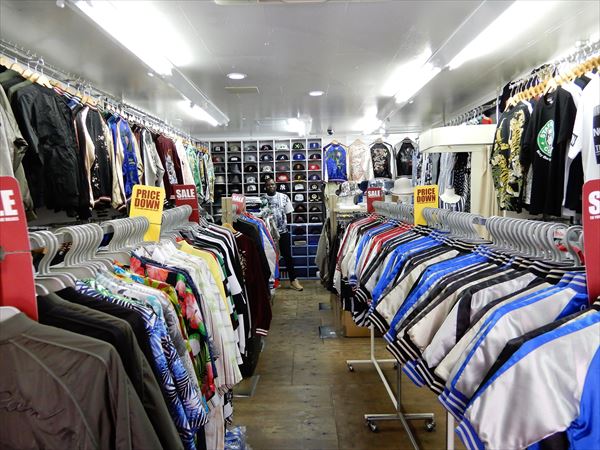
Skajan jackets hung in rows. There is also a wide variety of hats in the back of the store.
"Are you going to take pictures of me too?'' Mr. Emmanuel is surprisingly shy, and we ask him about the store's selection.
Sukajans for children that are worn on mannequins in stores start at around 4,000 yen, but the mainstream costs around 10,000 yen. The expensive ones cost around 20,000 yen. She showed me the suit.

Sukajan with cherry blossom embroidery on the back
The product, priced at 40,000 yen (tax included), has a surprisingly simple design. The reason it's so expensive is because it's reversible.

When you turn it over, there is no pattern. I think I can wear this anywhere
When I asked them about their recent sales, they said they were doing well. Although the overwhelming majority of customers are Japanese, the number of foreign tourists is also increasing.
In fact, shortly after I finished my interview and left the store, four white foreign men entered the store. After thinking that they had been inside the store for quite some time, the four of them finally came out. The last one was carrying a paper bag from the store.

Four people from “ACTIVE SOUL”
Immediately after they left, I went back to the store and asked Mr. Emmanuel, and he happily said, ``We sold a 46,000 yen (tax included) sukajan with dragon and tiger embroidery.'' The four people are probably tourists, not American soldiers.

Sukajan with the same pattern as the one I just bought
A must-visit store in the history of Sukajan on Dobuita Street
After that, I deviated from Dobuita Street and headed for the main road along National Route 16. This is because there is a store that Chairman Koshikawa mentioned repeatedly, and which cannot be ignored when talking about Sukajan.
The name of the store is "First Shokai." Ryoichi Matsuzaka, who was awarded a letter of appreciation in the "Birthplace of Skajan Sukajan Declaration" for his long-term contributions, runs Dobuita Street, which produces unique, fully custom-made products using traditional hand-stitching methods. It is a valuable store that remains in the shopping district.

The store with the blue tent is First Shokai.

This is what it looks like from the front. So cool!
Just as I arrived in front of the store, a young man wearing a Skajan jacket came out of the store.
Thinking he must be a regular customer, I approached him and he
answered, "Yes, I'm a customer, but I'm also learning.''
What, what do you mean? So I asked her further and she told me that she has an embroidery art atelier in Koganecho, Yokohama, and is learning sewing techniques from Ms. Matsuzaka. Her name is Daisuke Yamagami. She exchanged business cards and said goodbye.

Ms. Yamagami is learning embroidery from Ms. Matsuzaka.
Let's go inside the "First Shokai" store!
When I entered the store, I was greeted by Ms. Matsuzaka with a smile in front of her sewing machine.
He is now 88 years old. However, it is still in perfect working condition.
Mr. Matsuzaka, who was born in Yamagata, has been running this shop by himself for the past 34 years after a variety of experiences. He first used this store to sell souvenirs for American soldiers, but that was only a few years ago, and he has continued to manufacture and sell fully made-to-order Skajan jackets ever since.

Mr. Matsuzaka and his favorite sewing machine for many years
However, Matsuzaka does not produce all the products ordered by himself. Some items are ordered from outside sewing craftsmen. These craftsmen are not in Yokosuka but in places like Kiryu in Gunma Prefecture. Sukajan is supported by the sewing techniques of the northern Kanto region, where the textile industry has flourished since ancient times. However, even there, the number of craftsmen is gradually decreasing.
``Now that we have computerized sewing machines, the patterns of skajan jackets have changed a lot,'' Matsuzaka says.

Ms. Matsuzaka explains the difference between hand sewing and computer sewing in front of the displayed products.
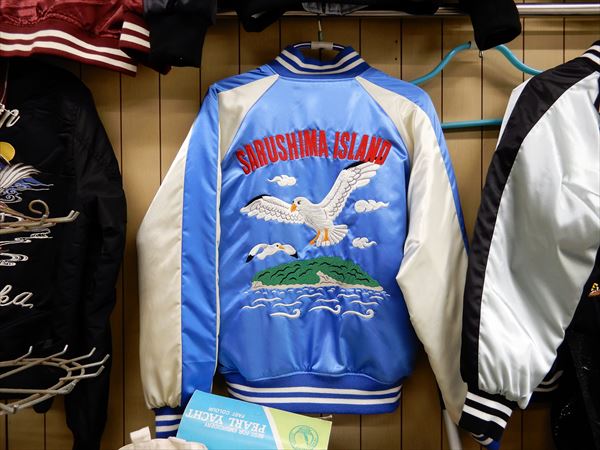
Hand-sewn sukajan made by Matsuzaka himself

Sukajan made by computer sewing machine
It is true that a computer may be able to draw more detailed depictions, but the three-dimensional feel and warmth of the designs, which are the most distinctive feature of Sukajan, are completely different.
However, computerized sewing machines do not require special skills from craftsmen, and the manufacturing costs are lower than that of hand sewing. This also makes it possible to set lower prices.
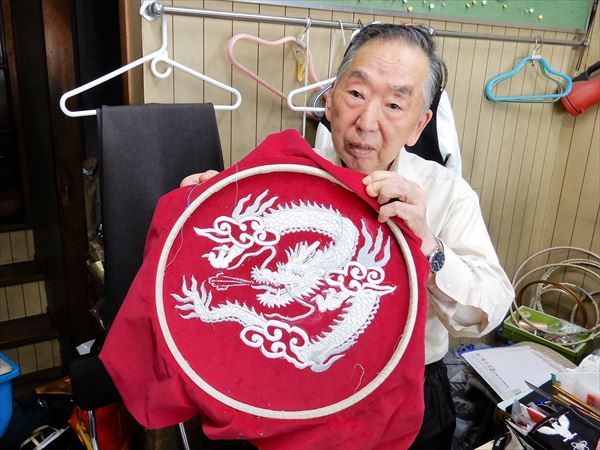
A dragon that you are currently making yourself. It still has a great three-dimensional feel
Mr. Matsuzaka then showed us various aspects of his production process. How to make a block copy using a gully block, which is rare now, the detailed design specification paper when requesting a craftsman, the structure of a horizontal sewing machine for sewing, etc. I felt Matsuzaka's personality in the way he generously shared his skills.
As for the number of customers, he says he has definitely seen an increase in the past few years.
Also, this restaurant has been known to have many regular customers from celebrities. From the mouths of Tetsuro Degawa, Takanori Jinnai, Nanase Aikawa, Junko Mihara... and Ms. Matsuzaka Names come up one after another.
Inside the store, completed photos of the main full-order products he has produced so far are arranged in albums, like an artist's portfolio.
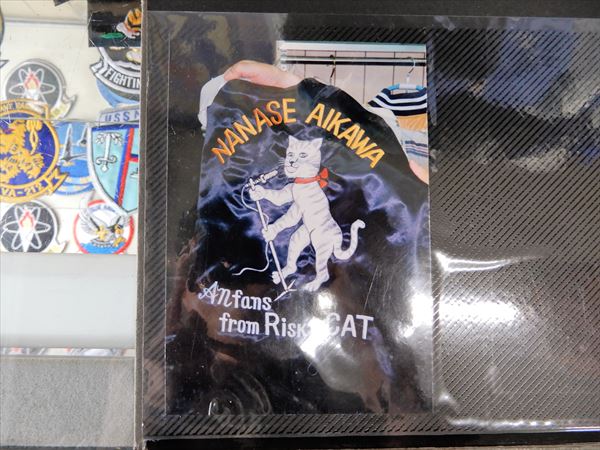
``This is Nanase Aikawa's sukajan,'' he said, showing me a photo.
Among the celebrities, one of our favorites is Ken Yokoyama of the Crazy Ken Band. He has made dozens of Skajan jackets at this shop, and says, ``Yesterday, I stopped by the shop while watching some TV broadcast.''

Sukajan with the name of the newly created Crazy Ken Band
However, the photo above is a product that a fan ordered for himself. When I asked about the price, I was told it was 38,000 yen (tax included).
The ready-made original Skajan jackets hanging on the walls of the store are currently on sale for 25,000 yen (tax included). ``Actually, considering the labor costs for the craftsmen, that doesn't make sense, but in order to compete with the computer sewing machine shops along Dobuita Street, we have no choice but to lower our prices,'' Matsuzaka says.
By the way, does Mr. Matsuzaka, who is 88 years old, have a successor?
When I asked him that question, he flatly replied, "No."
Her daughter lives in Tokyo, but she is not involved in this work. In other words, when Mr. Matsuzaka closes this shop, there will finally be no shop left in Yokosuka's Dobuita-dori shopping district that manufactures and sells completely custom original sukajans.
"But," Matsuzaka added. Around last year, young people who wanted to learn embroidery suddenly started coming to the store. It seems that about 6 people have already come. The man I encountered before entering the store was one of them.
This is an unprecedented phenomenon. The reason is not clear, but it can be considered a positive sign. The sun was starting to set when I
left First Shokai, where I lingered for quite some time, asking a former Navy man about his Skajan jacket at a bar that recognizes veterans of the U.S. military . Feeling something else missing, I returned to Dobuita Street. What caught my eye was a bar that looked like a place where American soldiers from the base would hang out.
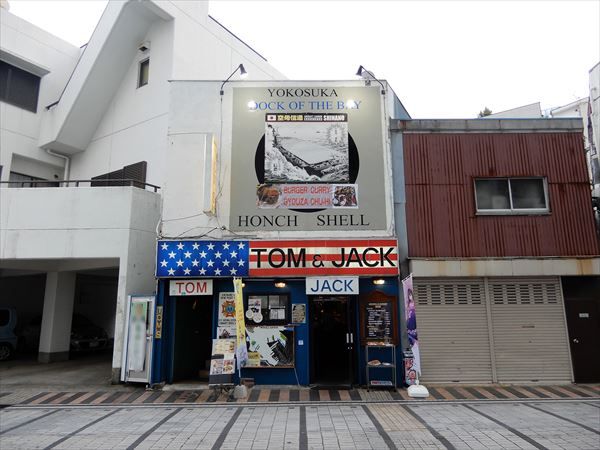
There are many signs posted showing the store's name. After all, what is the store name?
I take the plunge and go into the store. To ask, “Do you know Sukajan?”
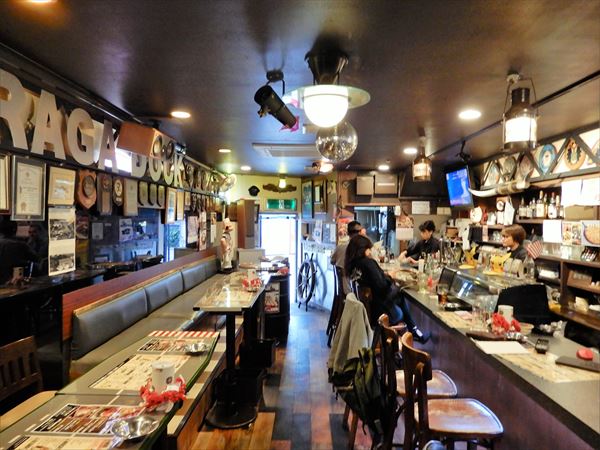
This is what the inside of the store looks like
I ordered a beer at the counter and watched for a while. During that time, I asked the woman at the store what her store name was, and she told me that her current name was "HONCH SHELL." Apparently, the name changed after the owner changed hands last year, and ``TOM&JACK'' was the previous name of the store. The design of the signboard is stylish, so they decided to leave it as is.
Eventually a white man came into the store and sat down next to the counter. He seemed like a kind person, so I started to say, ``Do you...'' but he immediately shut his mouth. This is because he started conversing fluently in Japanese with the store clerk.
Feeling a little relieved, I also called out to him in Japanese.
His name is Michael. He had been a regular customer of this store for 36 years since he came to Japan.

When I explained the situation, Frank agreed to an interview.
He was originally a soldier in the Navy, but quit and worked for a long time at a private company on base, and is now retired and living a leisurely life.
``I just woke up, so I probably still look half asleep,'' he laughs. It's an enviable situation.
Of course he knows about Sukajan, and he says he owns three of them. The first one was ``An eagle on the left chest, a cherry blossom on the right chest, and an eagle flying through the sky with a cherry blossom branch in its mouth...'' he explained in detail. It is said to be a masterpiece that he was proud of and bought for 40,000 yen.
All the female clerks also had Skajan jackets. "There's no one around here who doesn't own a Skajan jacket," says Michael. ``Many American soldiers on base also buy them,'' he said.
By the way, Dobuita Street is currently running a campaign called ``Sukajan Wari'', and at this store, for example, customers who come in wearing sukajans will receive a complimentary drink of either shochu or a highball. told me.
Afterwards, Michael shows us various items inside the store and emphasizes how special this store is. I didn't even understand half of what it meant, but when I looked into it later, I found out that this was one of the few restaurants certified by the Veterans of Foreign Wars (VFW), meaning it was a restaurant where American soldiers could drink safely.

The store displayed a variety of memorabilia related to veterans.
By the way, Michael also told me the origin of the name ``HONCH'' in this store.
The town name of Dobuita Street is ``Honcho''. Americans found it difficult to pronounce ``Dobuitadori,'' so they used the town name ``Honcho.'' Before I knew it, it was abbreviated to "honchi". Among American soldiers, this area is still called ``Honchi.''
Dobuita Street leads to Koganecho, Yokohama! ?
A few days later, I went to Koganecho, Yokohama to visit Daisuke Yamagami, a young man I met in front of First Shokai.
His atelier is located in the Koganecho Artist-in-Residence, which is located under the Keikyu Line elevated track near Koganecho Station. The former Blue Line District (illegal prostitution area) now hosts the Koganecho Bazaar art festival every fall , and has been transformed into an art village filled with studios and galleries.
Mr. Yamagami is 29 years old. He and his American wife, Sarah Johnson, have built a small atelier here called ``Johnagami Lab'' and are active as artists. Mr. Yamagami is in charge of production, and Mr. Sara is in charge of public relations such as the website.

Mr. Yamagami and Mr. Sara standing in front of the atelier
Mr. Yamagami and Mr. Matsuzaka of First Shokai first met about three years ago.
After graduating from design school, Yamagami was planning to exhibit at Tokyo's Design Festa when he happened to come across Matsuzaka's Sukajan at First Shokai, where he happened to be passing by. At that time, she thought it would be interesting to turn her design into a sukajan, so she initially ordered Matsuzaka to sew it and have it made into a sukajan.

A work from that time. A sketch by Yamagami and a sukajan sewn by Matsuzaka.
After that, as I ordered a few more items, I started to want to try sewing myself, and it was last September that I asked her to teach me how to do it. If I wanted to learn, I needed a sewing machine, so I immediately bought a horizontal sewing machine for embroidery, and since I needed a place to put the machine, I set up my atelier here. Mr. Yamagami's decisions and actions are quick.
Thanks to Mr. Matsuzaka's careful guidance, Mr. Yamagami was able to absorb more and more techniques in a short period of time. As a culmination of that effort, this is the piece I sewed myself last year.

Sukajan with a picture of Enma. It's hard to believe that this skill was acquired in just a few months.
I asked her to show me how to actually embroidery using a horizontal sewing machine.
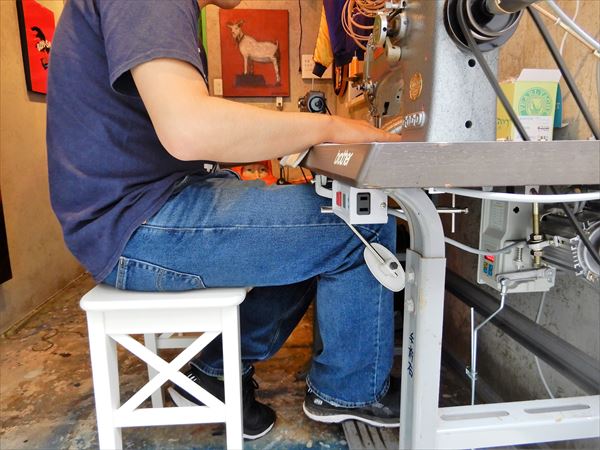
It looks like he is running the sewing machine casually, but pay attention to his right foot.
While controlling the speed of the needle with the tips of her feet, she uses her knees to adjust the width of the needle's horizontal movement.
Moreover, unlike sewing machines that only move the fabric forward and backward, horizontal swing machines do not have feed dogs to help guide the fabric. This is why it is possible to draw curves freely, but it also means that it is difficult to control the movement of the cloth.

The hoe-shaped part attached to the front of the needle is the feed dog (First Shokai's tailoring sewing machine)

This is not the case with embroidery machines. Instead, there is a groove that allows the needle to swing horizontally (First Shokai's horizontal swing sewing machine)
To operate a horizontal embroidery sewing machine, you must simultaneously control three delicate movements: your hands, feet, and knees. That's what's difficult, he says.
Ms. Yamagami hopes to continue creating works as an embroidery artist, making use of the techniques she learned from Ms. Matsuzaka of First Shokai.
However, as an artist, he is not limited only to Sukajan.

In the design room on the second floor, the two of them are considering works for this fall's Koganecho Bazaar.
The next piece is a giant 10 meter dragon created in collaboration with another artist. It is a large-scale project in which the body part will be made of embroidery.
Mr. Yamagami's words at the end of the interview left an impression on me.
``We are particular about having an atelier in Koganecho that utilizes Skajan sewing techniques.After the war, Yokosuka became a base town for the U.S. military, and Sukajan was born. The people who were forced out of the confiscated land lived there, and the town became unstable.Both places bear the shadow of the occupation era, and if something is wrong with the gears, this town will be destroyed. Something like ``Sukajan'' might have been born.''
There is a common thread somewhere. It seems that he receives such a feeling with the sensibility that is unique to an artist.
After the interview,
Mr. Yamagami also said the following in the interview.
"Skajans are now attracting worldwide attention and are being opened overseas.That's what makes them so appealing.In the future, I hope to gradually receive orders not only for works of art, but also for practical clothing. "and.
On the other hand, demand for sukajans is said to be increasing among young women as they have been featured in many fashion magazines since the Paris Fashion Week.
Also, the spread of low-priced computerized sewing machines is not a bad thing in terms of expanding the number of sewing enthusiasts.
Young people inheriting sewing techniques, new demand groups, diversification of products...The interview leaves a strong impression that ``the future of Sukajan is brighter'' than I had imagined before the survey.
- End -
Sukajan, which was born on Dobuita Street as a souvenir from the occupation forces, is synonymous with Yokosuka and is deeply popular among Japanese people. At a time when the cultural heritage that tells the story of postwar history is faced with the issue of a shortage of craftsmen, new prospects are opening up.
Speaking of ``Sukajan'', people tend to associate it with delinquent images such as flashy embroidery on the back, delinquent, tight-fitting clothes, and Regent clothes, but if you unravel the history of its birth and development, its postwar history will be revealed. It is also a valuable cultural heritage.

This is a monophonic sukajan! Special items lined up inside the long-established “First Shokai” store
What is the origin of Skajan?
The "ska" in Sukajan is, of course, the Yokosuka ska (though, strictly speaking, there are various theories). In the first place, after World War II, American soldiers stationed in Yokosuka brought fabric as souvenirs to their home country to a tailor who had a shop on Dobuita Street near the base, and asked them to make jumpers. It all started when I received oriental embroidery such as an eagle. It is said that the first cloth brought by American soldiers was parachute fabric (silk).
By the way, why was Dobuita Street called ``Dobuita''? That's because the Dobu River used to flow there. Because the river was an obstruction to traffic, the Imperial Japanese Navy Arsenal provided iron plates and covered the drains, hence the name ``Dobita Street.'' It is said that
Before the war, it flourished as a gate town for the Imperial Navy Yokosuka Naval Base, and after the war it became a souvenir shop, bar, and restaurant for the Occupation Forces, and later for American soldiers stationed at the U.S. Army Yokosuka Base. It flourished as a shopping street lined with stores and tailor shops.
For this reason, the Skajan jacket was initially called the ``souvenir jacket'' by American soldiers. It changed its name to the original jumper "Sukajan" from Yokosuka due to its links with new Japanese youth culture such as the rockabilly and rock 'n' roll boom of the 1960s and the Yankee boom of the 1970s, as well as the influence of American soldiers. This is because the customer base has shifted to Japanese.
What is the current situation in the local area of Sukajan, which has a history of post-war Showa era? In order to respond to Tako-san's request, I visited Dobuita Street in mid-May, just after the Reiwa era.
We ask the chairman of the Shopping District Promotion Association what he is up to now, more than a year after the "Declaration of the Birthplace of Sukajan"
The road to Dobuita-
dori Dobuita-dori is a 3-minute walk from Shiori Station. It is a shopping street with a total length of about 300 meters that stretches from east to west.
In fact, on February 12, 2018 (Heisei 30) last year, an event called ``Declaration of the Birthplace of Sukajan'' was held at Dobuita Dori Shopping Street. Yokosuka Mayor Katsuaki Kamiji and House of Representatives member Shinjiro Koizumi also wore Skajan jackets and gave speeches on stage, making it a huge success.
The commemorative plate made at that time is now embedded in the ground on Dobuita Street.

“Declaration of the Birthplace of Sukajan” commemorative plate embedded in the street
More than a year has passed since that event, and I visited the shop of Masamitsu Koshikawa, the chairman of the Dobuita Dori Shopping Street Promotion Association, to find out about the current state of Skajan jackets.
Chairman Koshikawa runs Futaba Costume Rental Store, located near the entrance to Dobuita Street. The store is a long-established store that has been in business for over 70 years.

Futaba Costume Shop is on the 3rd floor of the building on the right where the hearing aid store is located. What you can see on your left is “Dobuita Street”
According to Chairman Koshikawa, since the declaration, the number of customers coming from outside the city and prefecture to buy sukajans has increased, and neighboring stores off Dobuita Street have started purchasing skajans. The advertising effect seems to have been great.
The union is taking advantage of this opportunity to take even more proactive measures. For example, the sukajan jacket with the Olympic emblem embroidered on it is currently being produced for next year's Tokyo Olympics. This is said to be a joint project with the government.
They also made original T-shirts with a Sukajan pattern on them, which are currently on sale at Dobuita Station, an information center and antenna shop on Dobuita Street (2,700 yen including tax).

Chairman Koshikawa unfolds his “Sukajan T-shirt” to show us
We also spoke about the future of Skajan.
``Nowadays, even when it comes to sukajan, there are a wide variety of jackets. Cheap ones can be found for less than 10,000 yen, and high-quality ones can cost around 50,000 yen. As a union, we would like to differentiate ourselves.We would like to support the ``one-of-a-kind hand-sewn sukajan'' that customers who are looking for the real thing are looking for.''However, there are still products that require advanced sewing techniques
. The number of craftsmen who do this is said to be decreasing. That seems to be one of the big issues. After leaving Futaba Rental Costume Shop and visiting the
Sukajan specialty shops along Dobuita Street , I immediately set foot on Dobuita Street.

Dobuita Street has a quiet atmosphere in the afternoon on weekdays after the long holidays.
First, let's take a look at Dobuita Station, which sells Sukajan T-shirts.

“Dobuita Station” storefront
At the entrance, the ``Sukajan T-shirt'' I saw earlier was hung, along with tourist information guidebooks and maps. Inside the store, souvenirs such as various types of original T-shirts, navy curry, famous Yokosuka sweets, and miscellaneous goods are sold.
What particularly caught my eye was a photo frame on the wall to the left as I entered, proclaiming ``Yokosuka Stories of the Past and Present.''

There are many past and present photos of various parts of Yokosuka City.

Of course, there was also a photo of Dobuita Street.
To the left of Dobuita Station, there was a woody shop with Skajan jackets displayed in its window.

Sukajan in the shop window

Store adjacent to Dobuita Station
This store was ``MIKASA vol.2,'' one of the Sukajan specialty stores that handles authentic original products that Chairman Koshikawa said he would like to support. The company was founded in 1952 (Showa 27), when the San Francisco Peace Treaty went into effect and Japan regained its sovereignty. It is a long-established store.
I immediately entered the store and listened to the store manager, Kazuyoshi Hitomoto.
According to Director Koshikawa, Mr. Ippon is one of the key players in revitalizing Sukajan, including the ``Birthplace Declaration.''

The inside of the store. Ippon-san is in the back
According to Mr. Ippon, sales have indeed been steady since the ``Birthplace Declaration'', but even before that, Gucci and Louis Vuitton had used Sukajan at the 2016 Paris Fashion Week, drawing attention both domestically and internationally. It is said to be large. Since then, they have been featured more frequently in fashion magazines and on TV, and says, ``Normally fashion trends change every one to two years, but the demand for skajans has been stable, and it feels like their popularity has completely taken root.'' .
I asked Mr. Ippon which products are particularly popular in his store. The product he told me about is the one pictured below. It is said to be the most popular original design sukajan.

The most popular Sukajan. The price is 18,000 yen (excluding tax)
They also showed us some of their special items.

The one and only full order. This is 50,000 yen (excluding tax)
By the way, some Sukajan jackets have "Yokosuka" written on them, some have "Japan" written on them, and some have both written on them. As a souvenir for American soldiers, it was difficult to tell where the product was located using the word "Yokosuka," so they began to use the word "Japan," but Mr. Ippon is particular about using the name "Yokosuka."
Afterwards, I was able to talk to her mother, Reiko Hitomoto, the store's president, about the changes in her customer base.
When asked whether American soldiers still come to buy Skajan jackets as souvenirs, she answered, ``When a warship comes to port, there are people who come to buy them, but usually most of them are Japanese.'' thing. On the other hand, the number of foreign tourists has been increasing recently. Apparently some foreigners come to us saying that the restaurant was introduced in the guidebook on the plane.
She wanted to interview a different type of store besides the long-established ones, so she went further down Dobuita Street and found a kitschy store on her left.

A child's mannequin wearing a Skajan jacket is so cute!
When I entered the store, I found a cheerful black man there. This is Emmanuel, the owner of the HIPHOP casual shop ``ACTIVE SOUL.''
Mr. Emmanuel came to Japan from Nigeria 17 years ago and immediately started his current shop here on Dobuita Street.

Skajan jackets hung in rows. There is also a wide variety of hats in the back of the store.
"Are you going to take pictures of me too?'' Mr. Emmanuel is surprisingly shy, and we ask him about the store's selection.
Sukajans for children that are worn on mannequins in stores start at around 4,000 yen, but the mainstream costs around 10,000 yen. The expensive ones cost around 20,000 yen. She showed me the suit.

Sukajan with cherry blossom embroidery on the back
The product, priced at 40,000 yen (tax included), has a surprisingly simple design. The reason it's so expensive is because it's reversible.

When you turn it over, there is no pattern. I think I can wear this anywhere
When I asked them about their recent sales, they said they were doing well. Although the overwhelming majority of customers are Japanese, the number of foreign tourists is also increasing.
In fact, shortly after I finished my interview and left the store, four white foreign men entered the store. After thinking that they had been inside the store for quite some time, the four of them finally came out. The last one was carrying a paper bag from the store.

Four people from “ACTIVE SOUL”
Immediately after they left, I went back to the store and asked Mr. Emmanuel, and he happily said, ``We sold a 46,000 yen (tax included) sukajan with dragon and tiger embroidery.'' The four people are probably tourists, not American soldiers.

Sukajan with the same pattern as the one I just bought
A must-visit store in the history of Sukajan on Dobuita Street
After that, I deviated from Dobuita Street and headed for the main road along National Route 16. This is because there is a store that Chairman Koshikawa mentioned repeatedly, and which cannot be ignored when talking about Sukajan.
The name of the store is "First Shokai." Ryoichi Matsuzaka, who was awarded a letter of appreciation in the "Birthplace of Skajan Sukajan Declaration" for his long-term contributions, runs Dobuita Street, which produces unique, fully custom-made products using traditional hand-stitching methods. It is a valuable store that remains in the shopping district.

The store with the blue tent is First Shokai.

This is what it looks like from the front. So cool!
Just as I arrived in front of the store, a young man wearing a Skajan jacket came out of the store.
Thinking he must be a regular customer, I approached him and he
answered, "Yes, I'm a customer, but I'm also learning.''
What, what do you mean? So I asked her further and she told me that she has an embroidery art atelier in Koganecho, Yokohama, and is learning sewing techniques from Ms. Matsuzaka. Her name is Daisuke Yamagami. She exchanged business cards and said goodbye.

Ms. Yamagami is learning embroidery from Ms. Matsuzaka.
Let's go inside the "First Shokai" store!
When I entered the store, I was greeted by Ms. Matsuzaka with a smile in front of her sewing machine.
He is now 88 years old. However, it is still in perfect working condition.
Mr. Matsuzaka, who was born in Yamagata, has been running this shop by himself for the past 34 years after a variety of experiences. He first used this store to sell souvenirs for American soldiers, but that was only a few years ago, and he has continued to manufacture and sell fully made-to-order Skajan jackets ever since.

Mr. Matsuzaka and his favorite sewing machine for many years
However, Matsuzaka does not produce all the products ordered by himself. Some items are ordered from outside sewing craftsmen. These craftsmen are not in Yokosuka but in places like Kiryu in Gunma Prefecture. Sukajan is supported by the sewing techniques of the northern Kanto region, where the textile industry has flourished since ancient times. However, even there, the number of craftsmen is gradually decreasing.
``Now that we have computerized sewing machines, the patterns of skajan jackets have changed a lot,'' Matsuzaka says.

Ms. Matsuzaka explains the difference between hand sewing and computer sewing in front of the displayed products.

Hand-sewn sukajan made by Matsuzaka himself

Sukajan made by computer sewing machine
It is true that a computer may be able to draw more detailed depictions, but the three-dimensional feel and warmth of the designs, which are the most distinctive feature of Sukajan, are completely different.
However, computerized sewing machines do not require special skills from craftsmen, and the manufacturing costs are lower than that of hand sewing. This also makes it possible to set lower prices.

A dragon that you are currently making yourself. It still has a great three-dimensional feel
Mr. Matsuzaka then showed us various aspects of his production process. How to make a block copy using a gully block, which is rare now, the detailed design specification paper when requesting a craftsman, the structure of a horizontal sewing machine for sewing, etc. I felt Matsuzaka's personality in the way he generously shared his skills.
As for the number of customers, he says he has definitely seen an increase in the past few years.
Also, this restaurant has been known to have many regular customers from celebrities. From the mouths of Tetsuro Degawa, Takanori Jinnai, Nanase Aikawa, Junko Mihara... and Ms. Matsuzaka Names come up one after another.
Inside the store, completed photos of the main full-order products he has produced so far are arranged in albums, like an artist's portfolio.

``This is Nanase Aikawa's sukajan,'' he said, showing me a photo.
Among the celebrities, one of our favorites is Ken Yokoyama of the Crazy Ken Band. He has made dozens of Skajan jackets at this shop, and says, ``Yesterday, I stopped by the shop while watching some TV broadcast.''

Sukajan with the name of the newly created Crazy Ken Band
However, the photo above is a product that a fan ordered for himself. When I asked about the price, I was told it was 38,000 yen (tax included).
The ready-made original Skajan jackets hanging on the walls of the store are currently on sale for 25,000 yen (tax included). ``Actually, considering the labor costs for the craftsmen, that doesn't make sense, but in order to compete with the computer sewing machine shops along Dobuita Street, we have no choice but to lower our prices,'' Matsuzaka says.
By the way, does Mr. Matsuzaka, who is 88 years old, have a successor?
When I asked him that question, he flatly replied, "No."
Her daughter lives in Tokyo, but she is not involved in this work. In other words, when Mr. Matsuzaka closes this shop, there will finally be no shop left in Yokosuka's Dobuita-dori shopping district that manufactures and sells completely custom original sukajans.
"But," Matsuzaka added. Around last year, young people who wanted to learn embroidery suddenly started coming to the store. It seems that about 6 people have already come. The man I encountered before entering the store was one of them.
This is an unprecedented phenomenon. The reason is not clear, but it can be considered a positive sign. The sun was starting to set when I
left First Shokai, where I lingered for quite some time, asking a former Navy man about his Skajan jacket at a bar that recognizes veterans of the U.S. military . Feeling something else missing, I returned to Dobuita Street. What caught my eye was a bar that looked like a place where American soldiers from the base would hang out.

There are many signs posted showing the store's name. After all, what is the store name?
I take the plunge and go into the store. To ask, “Do you know Sukajan?”

This is what the inside of the store looks like
I ordered a beer at the counter and watched for a while. During that time, I asked the woman at the store what her store name was, and she told me that her current name was "HONCH SHELL." Apparently, the name changed after the owner changed hands last year, and ``TOM&JACK'' was the previous name of the store. The design of the signboard is stylish, so they decided to leave it as is.
Eventually a white man came into the store and sat down next to the counter. He seemed like a kind person, so I started to say, ``Do you...'' but he immediately shut his mouth. This is because he started conversing fluently in Japanese with the store clerk.
Feeling a little relieved, I also called out to him in Japanese.
His name is Michael. He had been a regular customer of this store for 36 years since he came to Japan.

When I explained the situation, Frank agreed to an interview.
He was originally a soldier in the Navy, but quit and worked for a long time at a private company on base, and is now retired and living a leisurely life.
``I just woke up, so I probably still look half asleep,'' he laughs. It's an enviable situation.
Of course he knows about Sukajan, and he says he owns three of them. The first one was ``An eagle on the left chest, a cherry blossom on the right chest, and an eagle flying through the sky with a cherry blossom branch in its mouth...'' he explained in detail. It is said to be a masterpiece that he was proud of and bought for 40,000 yen.
All the female clerks also had Skajan jackets. "There's no one around here who doesn't own a Skajan jacket," says Michael. ``Many American soldiers on base also buy them,'' he said.
By the way, Dobuita Street is currently running a campaign called ``Sukajan Wari'', and at this store, for example, customers who come in wearing sukajans will receive a complimentary drink of either shochu or a highball. told me.
Afterwards, Michael shows us various items inside the store and emphasizes how special this store is. I didn't even understand half of what it meant, but when I looked into it later, I found out that this was one of the few restaurants certified by the Veterans of Foreign Wars (VFW), meaning it was a restaurant where American soldiers could drink safely.

The store displayed a variety of memorabilia related to veterans.
By the way, Michael also told me the origin of the name ``HONCH'' in this store.
The town name of Dobuita Street is ``Honcho''. Americans found it difficult to pronounce ``Dobuitadori,'' so they used the town name ``Honcho.'' Before I knew it, it was abbreviated to "honchi". Among American soldiers, this area is still called ``Honchi.''
Dobuita Street leads to Koganecho, Yokohama! ?
A few days later, I went to Koganecho, Yokohama to visit Daisuke Yamagami, a young man I met in front of First Shokai.
His atelier is located in the Koganecho Artist-in-Residence, which is located under the Keikyu Line elevated track near Koganecho Station. The former Blue Line District (illegal prostitution area) now hosts the Koganecho Bazaar art festival every fall , and has been transformed into an art village filled with studios and galleries.
Mr. Yamagami is 29 years old. He and his American wife, Sarah Johnson, have built a small atelier here called ``Johnagami Lab'' and are active as artists. Mr. Yamagami is in charge of production, and Mr. Sara is in charge of public relations such as the website.

Mr. Yamagami and Mr. Sara standing in front of the atelier
Mr. Yamagami and Mr. Matsuzaka of First Shokai first met about three years ago.
After graduating from design school, Yamagami was planning to exhibit at Tokyo's Design Festa when he happened to come across Matsuzaka's Sukajan at First Shokai, where he happened to be passing by. At that time, she thought it would be interesting to turn her design into a sukajan, so she initially ordered Matsuzaka to sew it and have it made into a sukajan.

A work from that time. A sketch by Yamagami and a sukajan sewn by Matsuzaka.
After that, as I ordered a few more items, I started to want to try sewing myself, and it was last September that I asked her to teach me how to do it. If I wanted to learn, I needed a sewing machine, so I immediately bought a horizontal sewing machine for embroidery, and since I needed a place to put the machine, I set up my atelier here. Mr. Yamagami's decisions and actions are quick.
Thanks to Mr. Matsuzaka's careful guidance, Mr. Yamagami was able to absorb more and more techniques in a short period of time. As a culmination of that effort, this is the piece I sewed myself last year.

Sukajan with a picture of Enma. It's hard to believe that this skill was acquired in just a few months.
I asked her to show me how to actually embroidery using a horizontal sewing machine.

It looks like he is running the sewing machine casually, but pay attention to his right foot.
While controlling the speed of the needle with the tips of her feet, she uses her knees to adjust the width of the needle's horizontal movement.
Moreover, unlike sewing machines that only move the fabric forward and backward, horizontal swing machines do not have feed dogs to help guide the fabric. This is why it is possible to draw curves freely, but it also means that it is difficult to control the movement of the cloth.

The hoe-shaped part attached to the front of the needle is the feed dog (First Shokai's tailoring sewing machine)

This is not the case with embroidery machines. Instead, there is a groove that allows the needle to swing horizontally (First Shokai's horizontal swing sewing machine)
To operate a horizontal embroidery sewing machine, you must simultaneously control three delicate movements: your hands, feet, and knees. That's what's difficult, he says.
Ms. Yamagami hopes to continue creating works as an embroidery artist, making use of the techniques she learned from Ms. Matsuzaka of First Shokai.
However, as an artist, he is not limited only to Sukajan.

In the design room on the second floor, the two of them are considering works for this fall's Koganecho Bazaar.
The next piece is a giant 10 meter dragon created in collaboration with another artist. It is a large-scale project in which the body part will be made of embroidery.
Mr. Yamagami's words at the end of the interview left an impression on me.
``We are particular about having an atelier in Koganecho that utilizes Skajan sewing techniques.After the war, Yokosuka became a base town for the U.S. military, and Sukajan was born. The people who were forced out of the confiscated land lived there, and the town became unstable.Both places bear the shadow of the occupation era, and if something is wrong with the gears, this town will be destroyed. Something like ``Sukajan'' might have been born.''
There is a common thread somewhere. It seems that he receives such a feeling with the sensibility that is unique to an artist.
After the interview,
Mr. Yamagami also said the following in the interview.
"Skajans are now attracting worldwide attention and are being opened overseas.That's what makes them so appealing.In the future, I hope to gradually receive orders not only for works of art, but also for practical clothing. "and.
On the other hand, demand for sukajans is said to be increasing among young women as they have been featured in many fashion magazines since the Paris Fashion Week.
Also, the spread of low-priced computerized sewing machines is not a bad thing in terms of expanding the number of sewing enthusiasts.
Young people inheriting sewing techniques, new demand groups, diversification of products...The interview leaves a strong impression that ``the future of Sukajan is brighter'' than I had imagined before the survey.
- End -
